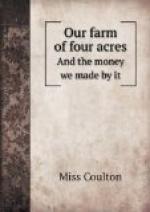It is necessary that a pan of water should be place in their house each day for them to wash in, and that a large lump of bay-salt should likewise be kept there. It should be occasionally cleaned out, and this is all the trouble attending keeping them. Feed them three times a day; and never throw more down than they pick up at a meal.
As I have said nothing of the profit derived from chickens when they are reared by the owner, so I now say nothing of the saving in keeping pigeons, when we came to sow a large patch of Indian corn, as well as some tares. We did so successfully in the acre of ground called the Orchard; and though we had abundance of fine fruit from it, the trees were not planted so thickly as to prevent any kind of crop from flourishing. But we repeat, this little book is a manual for the use of the beginner; and to such we hope it may prove both useful and encouraging.
CHAPTER X.
HOW WE CURED OUR HAMS.
I have now recounted our experience in keeping cows, pigs, chickens, ducks, rabbits, and pigeons; and with everything but the rabbits we were amply satisfied with the return we received for our labor. We had a constant supply of milk, butter, eggs, ducks, chickens, and pork, not only fresh, but in the shape of good hams and bacon.
I do not know whether it is not presumptuous, in the face of Miss Acton, Mrs. Rundle, and so many other authorities, not forgetting the great Alexis Soyer, to give “our method of curing” the last-mentioned dainties; but we think we may as well follow up the history of our pigs, from the sty to the kitchen. I always found that the recipes usually given for salting pork contained too much saltpetre, which not only renders the meat hard, but causes it to be very indigestible. The following is the manner in which they were cured by ourselves:
For each ham of twelve pounds weight:
Two pounds of common salt.
Two ounces of saltpetre.
1/4 pound of bay salt.
1/4 pound of coarse sugar.
The hams to be well rubbed with this mixture, which must be in the finest powder. It is always the best plan to get your butcher to rub the meat, as a female hand is hardly heavy enough to do it effectually; they are then placed in a deep pan, and a wine-glass of vinegar is added. They should be turned each day; and for the first three or four should be well rubbed with brine. After that time it will be sufficient, with a wooden or iron spoon, to well ladle it over the meat. They should remain three weeks in the pickle. When removed from it, they must be well wiped, put in brown-paper bags, and then smoked the wood smoke for three weeks.
We once had nearly a whole pig spoiled by its being taken to a baker’s, where it was dried, but not smoked. When it came back it resembled very strong tallow.
In villages it is usual to send bacon and hams to be dried in the chimneys of farm-houses where wood is burnt, in the old-fashioned manner, on dogs; but if resident in or near a small town, there is always a drying-house to be met with, where we believe sawdust is used for fuel. We have had our own dried in this manner, and always found them excellent.




